
Drosera rotundifolia, the round-leaved sundew, roundleaf sundew, or common sundew, is a carnivorous species of flowering plant that grows in bogs, marshes and fens. One of the most widespread sundew species, it has a circumboreal distribution, being found in all of northern Europe, much of Siberia, large parts of northern North America, Korea and Japan but is also found as far south as California, Mississippi and Alabama in the United States of America and in New Guinea.

Subularia aquatica is an aquatic plant in the family Brassicaceae which is known by the common name water awlwort. This is a small herb with awl-like leaves, and growing from a corm above a network of bright white roots. Tiny flowers, each only about a millimeter long, are borne on stalks. Flowers which rise above the surface of the water open, while those that remain submersed stay closed and self-pollinate. The seeds come inside tiny inflated pods. There are two varieties of water awlwort; S. a. var. aquatica is native to Eurasia and S. a. var. americana is native to northern North America. There may also be a Mexican subspecies. This plant grows in ponds, marshes, peat bogs, and other shallow, cold water bodies, often in gravel or sand.

Boloria chariclea, the Arctic fritillary or purplish fritillary, is a butterfly of the family Nymphalidae. It is found in the northern parts of the Palearctic and Nearctic realms.

Nymphalis vaualbum or N. l-album, the Compton tortoiseshell, or false comma, is a species of butterfly in the family Nymphalidae.

Colias nastes, the Labrador sulphur, is a butterfly in the family Pieridae. In Europe, it is found in the north of Norway and Sweden and on rare occasions in northern Finland. It is also found in North America, specifically in Alaska, Canada, and the Rocky Mountains, Washington, Montana and on Greenland. In Asia, it is found in the Altai Mountains, the border regions of Russia, China, Mongolia, Kazakhstan, the Sayan Mountains, the north of Siberia, and in the Chukotka Autonomous Okrug.

Agrotis ruta is a moth of the family Noctuidae first described by Eduard Friedrich Eversmann in 1851. It has a Holarctic distribution. In North America it has a northern distribution, occurring from Alaska and the Yukon Territory to Labrador, south to northern Manitoba and British Columbia, and in the Rocky Mountains to southern Alberta. Furthermore, it can be found in the northern Urals, Siberia, Mongolia, China and Japan.

Alypia ridingsii, the mountain forester or Ridings' forester, is a moth of the family Noctuidae. The species was first described by Augustus Radcliffe Grote in 1864. It is found in North America as far east as the eastern edge of the Rocky Mountains in Colorado. It is also found in Arizona, Utah, all of California and northward into Oregon, Idaho, Washington, British Columbia and Alaska
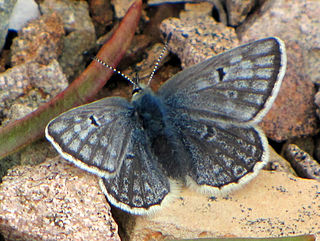
Agriades glandon, the Arctic blue or Glandon blue, is a species of butterfly in the family Lycaenidae. It in found in Eurasia and North America.
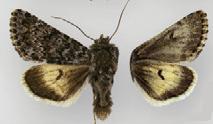
Lasionycta leucocycla is a moth of the family Noctuidae. It can be found in Scandinavia, Siberia and northern North America.
Euxoa campestris, the flat dart, is a moth of the family Noctuidae. The species was first described by Augustus Radcliffe Grote in 1875. It is found in North America from Newfoundland to Alaska, south to New England and southern Canada from southern Quebec west to British Columbia. In the west it is distributed southward in the Rocky Mountains to southern New Mexico, east-central Arizona, and central Utah. In the east it occurs in the Appalachians in eastern Kentucky and in western North Carolina.
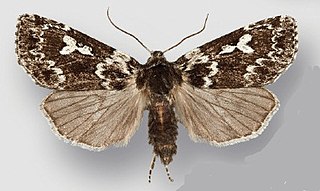
Xestia perquiritata, the boomerang dart, is a moth of the family Noctuidae. The species was first described by Herbert Knowles Morrison in 1874. It is found across North America from Newfoundland, Labrador and northern New England, west to central Yukon, British Columbia and Washington. There are several disjunct populations, including one in the Great Smoky Mountains National Park and the Rocky Mountains in Colorado and a coastal bog in central Oregon.

Xestia smithii, or Smith's dart, is a moth of the family Noctuidae. The species was first described by Pieter Cornelius Tobias Snellen in 1896. It is found across northern North America from Newfoundland to Alaska. In the eastern United States it occurs from Maine to Virginia and south along the Appalachians to North Carolina. In the west it is found in the Black Hills in western South Dakota and north-eastern Wyoming, in the Rocky Mountains from Montana to New Mexico, south-eastern Arizona, and from Washington to east central California. It has recently been recorded from Tennessee.
Diarsia dislocata, the dislocated dart, is a moth of the family Noctuidae. It is found in Alaska and Ontario, Quebec, New Brunswick, Newfoundland and Labrador, British Columbia, Alberta, Saskatchewan, the Northwest Territories, Yukon and Manitoba in Canada. It is also found in the north-eastern parts of the United States, Washington and Colorado.

Euxoa ochrogaster, the red-backed cutworm, is a moth of the family Noctuidae. It is found from Iceland and northern Europe, through the Baltic to the Amur region. In North America, it is found from Alaska to Newfoundland and Labrador, south into the northern part of the United States, south in Rocky Mountains to Arizona and New Mexico.
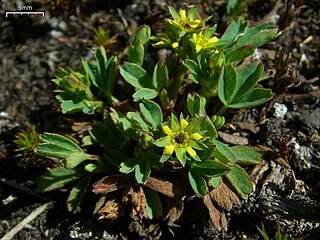
Sibbaldia procumbens is a species of flowering plant of the genus Sibbaldia in the rose family. It has an Arctic–alpine distribution; it can be found throughout the Arctic, as well as the at higher elevations in the mountains of Eurasia and North America. It grows on tundra and in alpine climates where snow remains year-round, and on subalpine mountain slopes. This is a low, mat-forming perennial herb producing clumps of herbage in rocky, gravelly substrate. A spreading stem up to 15 centimeters long grows from a caudex. Each leaf is divided into usually three leaflets borne at the end of a petiole up to 7 centimeters long. Each wedge-shaped leaflet has three teeth at the tip. The flower has usually five pointed green bractlets, five wider pointed green sepals, and five tiny yellowish petals each about a millimeter long. The fruits develop in the remnants of the sepals on erect stalks.
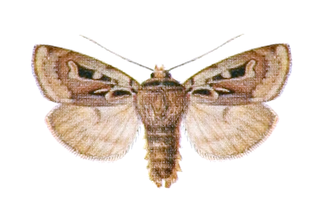
Xestia wockei is a moth of the family Noctuidae. It is known from Siberia and northern North America, including Quebec, Newfoundland and Labrador, the Northwest Territories and Yukon.

Xestia tecta is a moth of the family Noctuidae. In Europe the species is only known from the boreal area of Fennoscandia, north-western Russia and the northern Ural Mountains. Outside Europe it occurs in northern and central Siberia and the north-western USA including Alaska as well as north-western and central Canada.

Oeneis bore, the white-veined Arctic or Arctic grayling, is a butterfly, a species of Satyrinae that occurs in North America and Asia.
Gynaephora rossii, in English known as Ross' tussock moth, is a species of tussock moth in the family Erebidae. It is widespread in the tundras and highlands of the Holarctic. It has large, furry caterpillars which seem to eat mostly saxifrages.

Sibbaldia is a genus of flowering plants of the family Rosaceae, with a circumpolar distribution, including the high Arctic. Most of the species are found in the Himalaya. The type species is Sibbaldia procumbens. It is also in the Rosoideae subfamily.















